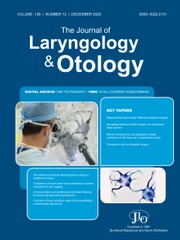Crossref Citations
This article has been cited by the following publications. This list is generated based on data provided by
Crossref.
van der Avoort, Stijn J. C.
van Heerbeek, Niels
Admiraal, Ronald J. C.
Zielhuis, Gerhard A.
and
Cremers, W. R. J.
2008.
Results of Sonotubometry in Testing Eustachian Tube Ventilatory Function in Children with Cleft Palate.
Annals of Otology, Rhinology & Laryngology,
Vol. 117,
Issue. 5,
p.
335.
Kong, Soo-Keun
2009.
Diagnosis and Management of the Patulous Eustachian Tube.
Journal of Clinical Otolaryngology Head and Neck Surgery,
Vol. 20,
Issue. 2,
p.
149.
Poe, Dennis S.
and
Handzel, Ophir
2010.
Otologic Surgery.
p.
93.
Di Martino, Ercole F. N.
Nath, Viorel
Telle, Aulis
Antweiler, Christiane
Walther, Leif E.
and
Vary, P.
2010.
Evaluation of Eustachian tube function with perfect sequences: technical realization and first clinical results.
European Archives of Oto-Rhino-Laryngology,
Vol. 267,
Issue. 3,
p.
367.
Handzel, Ophir
Poe, Dennis
and
Marchbanks, Robert J.
2012.
Synchronous Endoscopy and Sonotubometry of the Eustachian Tube.
Otology & Neurotology,
Vol. 33,
Issue. 2,
p.
184.
Smith, M.E.
and
Tysome, J.R.
2015.
Tests of Eustachian tube function: a review.
Clinical Otolaryngology,
Vol. 40,
Issue. 4,
p.
300.
Swarts, J. Douglas
Teixeira, Miriam S.
Banks, Juliane
El-Wagaa, Jenna
and
Doyle, William J.
2015.
A method to assess the accuracy of sonotubometry for detecting Eustachian tube openings.
European Archives of Oto-Rhino-Laryngology,
Vol. 272,
Issue. 9,
p.
2111.
Beleskiene, Vilma
Lesinskas, Eugenijus
Januskiene, Vaida
Daunoraviciene, Kristina
Rauba, Darius
and
Ivaska, Justinas
2016.
Eustachian Tube Opening Measurement by Sonotubometry Using Perfect Sequences for Healthy Adults.
Clinical and Experimental Otorhinolaryngology,
Vol. 9,
Issue. 2,
p.
116.
Beleškiene, Vilma
and
Lesinskas, Eugenijus
2016.
AUSIES TRIMITO FUNKCIJOS VERTINIMAS ASMENIMS SU PASUNKĖJUSIU KVĖPAVIMU PER NOSĮ, ATLIEKANT IDEALIOS SEKOS DAŽNIŲ SONOTUBOMETRIJĄ.
Medicinos teorija ir praktika,
Vol. 22,
Issue. 1,
p.
28.
Ikhwan, M
Hafil, A F
and
Bramanthyo, B
2017.
Determination of eustachius tube ventilation functioning among benign type chronic suppurative otitis media and non-otitis media subjects using sonotubometry.
Journal of Physics: Conference Series,
Vol. 884,
Issue. ,
p.
012144.
Smith, Matthew E.
Zou, Charlie C.
Baker, Charlotte
Blythe, Andrew J. C.
Hutchinson, Peter J. A.
and
Tysome, James R.
2017.
The repeatability of tests of eustachian tube function in healthy ears.
The Laryngoscope,
Vol. 127,
Issue. 11,
p.
2619.
Bashiruddin, J
Martiastini A, R
Alviandi, W
and
Prihartono, J
2018.
Conformity between sonotubometry and tympanometry in examining eustachian tube ventilatory function in adults with normal hearing.
Journal of Physics: Conference Series,
Vol. 1073,
Issue. ,
p.
022023.
Smith, Matthew E.
Bance, Manohar L.
and
Tysome, James R.
2019.
Advances in Eustachian tube function testing.
World Journal of Otorhinolaryngology - Head and Neck Surgery,
Vol. 5,
Issue. 3,
p.
131.
Asakura, T.
Ishii, T.
and
Miwa, M.
2021.
Evaluation of eustachian tube function using a portable device.
JASA Express Letters,
Vol. 1,
Issue. 6,
Bae, Seong Hoon
Moon, Seojin
Jeong, Mincheol
and
Moon, In Seok
2022.
Revisiting the Diagnostic Performance of the Modified Nine-Step Test for Obstructive and Patulous Eustachian Tube Dysfunction.
Diagnostics,
Vol. 12,
Issue. 3,
p.
732.
Li, Jingyu
Ruan, Kaian
Tan, Songhua
Xie, Lihong
Liu, Lei
Liu, Xinmiao
and
Tang, Anzhou
2022.
A Novel Eustachian Tube Test: Preliminary Research of Sonotubometry With Nasopharynx Under Pressure.
Otology & Neurotology,
Vol. 43,
Issue. 5,
p.
580.
Kim, Jun Yup
Kim, Dachan
Moon, In Seok
Han, Ji Hyuk
and
Bae, Seong Hoon
2024.
Interpretation of the nine‐step test for Eustachian tube function should consider mastoid cavity volume.
Clinical Otolaryngology,




